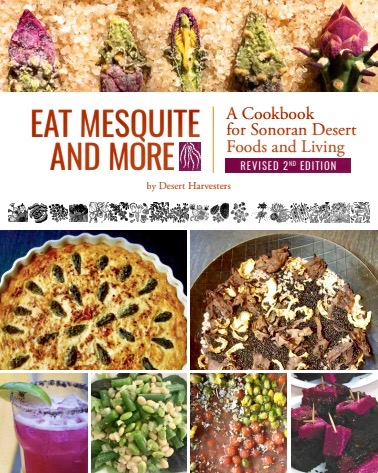
Time–to be exact, good timing, plus duration and patience–are necessary ingredients in making most good dishes. All of these are enlisted in creating festive cordials. Here, a native fan palm cordial made with tiny wild dates (in bowl), harvested & put up in the fall…after months later… produced a luscious cordial for a sweet Valentine surprise. Time to celebrate! (MABurgess photo)
Let’s tip a toast to Father Time who allows magic to be wrought upon our local desert fruits. The joyous results of his temporal magic can be festive and delightful cordials. With a little industry, when our desert fruits are ripe in late summer or fall, there can be heartwarming dessert drinks to help celebrate chilly winter evenings–and especially fine for your favorite Valentine.
Tia Marta here, with an additional toast, this one to the father of Slow Knowledge, agricultural philosopher/author Wendell Berry. His “slow knowledge”–yea wisdom–comes with growing one’s own food (or wild-harvesting), watching the near-imperceptable progress played by Nature and Father Time on leafing, flowering, fruiting, fermentation, decay of individual plants, small or tall, in garden, farm, wild desert, forest. Being present is a key to “slow knowledge,” something sorely missed if one is always absorbed in a device. Lack of slow knowledge may lead to atrophy of human brain neurons. There is evidence that practicing slow knowledge, being out in Nature, in fact enhances brain function and development, broadens associative thinking, deductive and inductive reasoning, adds serenity, promotes compassion….Hey what’s not to like about it?

We had left our Meyer lemons on the tree past the holidays to fully sweeten up. When frost was predicted, we quick-harvested 52 giant juicy fruits from one little tree! (MABurgess photo)

Meyer lemon does well in a low desert garden. It’s juice is so sweet and even its thin rind is edible! All parts of Meyer lemon are used in creating limoncello. Juice and thinly sliced rind all go into the mix to mull. (MABurgess photo)

Time and tequila produced the finest limoncello ever with Meyer lemon! (MABurgess photo)
I’d like to share four of my favorite ways–four cordials– to celebrate time, with fruits that our Southwest gardens, orchards, and even prickly desert can supply in plenty: 1) Native fan palm “Desert Oasis Cordial” depicted above made with the seedy dates of our ubiquitous Washingtonia filifera (Read more by searching Jan.20, 2015’s post in this blog archive), 2) special Meyer Limoncello, 3) Prickly Pear Cordial, and 4) Colorado Cherry Cordial. They are really so easy to make with speedy prep-time– a good investment in one’s spare minutes when there is a bumper crop of fruits shouting for attention.
General Cordial Instructions: In order for all four cordials to “make,” i.e. to sit and mull, you will need a sanitized sealable crock or large canning jar. Wash and cut your fruits (no need to cut the teensy native palm dates), measure equal quantities of:
a) fruit,
b) spirits (I use good 100% agave tequila or mescal, but vodka also works fine), and
c) a natural sweetener (I use agave nectar but my mother used sugar successfully).
Pack fruit into jars, add sweetener, cover with spirits, seal, and set aside in a cool, dark place for as many weeks or months as possible, checking periodically for progress or problems.

After mulling for months in tequila, the halved prickly pear tunas have lost their bright purple color but have lost none of their great flavor! Mash to free up their juices.

Decant by filtering prickly pear fruit&juice mix, separating fruit, seed, and remaining spines using a masher and coffee filter set in a funnel over a bowl or measuring cup to capture the precious cordial.

Several folded layers of cheesecloth set in a funnel can be used in decanting the prickly pear cordial.
Essentially, with the help of Time, you are making a sweet herbal tincture. Decanting is the next step. Remember those gorgeous rosey red prickly pear tunas gathered carefully in August? (Yes, planning ahead is paramount. Put it on your calendar now for next August.) At harvest, I washed and removed as many spines as possible, cut them in half, and set them in the canning jar, seeds and all, with the other ingredients. Now at decanting time I must make sure to filter out all solid parts to clarify the cordial. Coffee filters or layered cheesecloth resting in a funnel over your catcher-cup or bottle will work perfectly. After filtering, store your cordial in glass indefinitely–to enjoy on special occasions.

Prickly Pear Cordial sits next to its drought-stressed provider, Engelmann’s prickly pear (Opuntia engelmannii) the winter after a grand August harvest. What gifts these plants provide! Given rain, they bounce back to give more next year. (MABurgess)

Colorado Cherry Cordial with delicious “marinated” cherries to be used for topping on ice cream. (MABurgess photo)
You can view native fan palms on the University of Arizona campus, lemon trees at the Tucson Botanical Garden, and Engelmann’s prickly pear close up at the Arizona-Sonora Desert Museum and at Tucson’s Mission Garden. Find more traditional foods at http://www.flordemayoarts.com and http://www.nativeseeds.org. And watch for upcoming City of Gastronomy tours in Tucson beginning in March at Tucson’s Presidio Museum–Stay tuned at http://www.tucsonpresidio.com.
Now a cordial toast to you, dear Savor Blog Follower! May you delight in these spirited fruits of the desert and delight in the time they take to bring us this cheer!









































